Radium's Line of Focus ST/RS Parts - How it Fits into Your Build
November 29th, 2023
7 min read
By JP Alonso

One of our favorite brands to discuss with customers is Radium Engineering. If there is a brand that hits the nail on the head with every product release, it's Radium. If they make a part for your car, it has a good chance of being the best version on the market. Function and form seem to be loosely used terms in the aftermarket performance world. With Radium Engineering, they set the bar for what it should mean. The words elegant, useful, and drool-worthy all ring true with every part they pump out. When it comes to the Ford Focus ST and Focus RS, here's what Radium has to offer and our take on how it can help your build be a success.
Radium makes some parts that quite frankly, nobody else wants to make. And it's not that competitors can't make their own version. At the end of the day, engineers and machinists can make damn near anything these days. But it's easy to see that Radium is dipping into more complex, more sensitive projects that many others are not willing to spend their time, energy, and skill on. Fitment, electrical, pressure, flow, materials, tight tolerances, and more, are all factors going into Radium's range of products. From basic fittings to full fuel cells with integrated surge tanks and pumps, it has to be just right. So thank heavens for the folks at Radium for making seriously cool stuff at a high level without compromising performance and functionality.
On the Focus ST and Focus RS, here are the range of parts they offer, with a quick note about which car they fit. Click to skip to the one you're interested in or just read through all of them, like a true performance geek 😉.
Catch Can Kit - PCV
Catch Can Kit - Crankcase
Dual Catch Can Kit - Includes both PCV and Crankcase
PCV Baffle Plate Kit
Symposer Delete Kit
Coolant Tank Kit
Fuel Filter Kit
Port Injection Kit
Surge Tank Install Kit
Catch Can Kits
Both the PCV and crankcase catch can kits make up the dual kit, so I won't talk about the dual can kit itself, but just know it comes with both.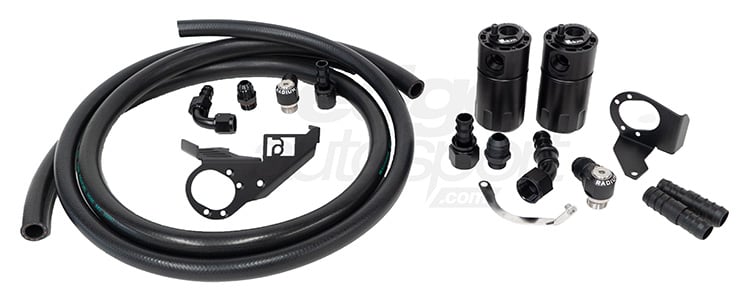
PCV Catch Can (All Focus ST and RS Models)
The PCV (positive crankcase ventilation) catch can kit goes between the factory PCV valve and intercepts the oil vapors traveling between the crankcase and the intake manifold during a vacuum state. So when you're sitting at a red light or in a parking lot idling or you're on a flat road kicking back on cruise control, the PCV is allowing the crankcase to vent into the intake manifold. Along with that pressure release, oil vapor and other contaminants from the combustion process sneak past the piston rings. That is not what should be recycled through your intake (but those are the rules). The catch can retains those harmful molecules and only lets clean air back into the intake, keeping those valves so fresh and so clean. Something of note, a symposer delete kit is required to use this kit on the Focus ST models.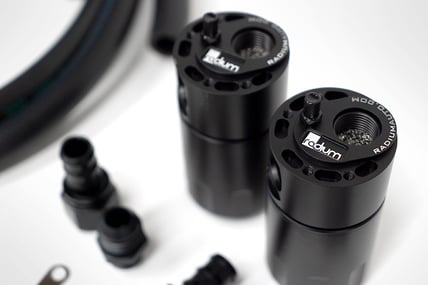
Crankcase Vent Catch Can (Separate Kits, one for Focus ST 2015-2018 and one for Focus RS 2016-2018)
Like the PCV can, this also captures the same oil vapor and contaminants that are by-products of blow-by, pressure, heat, etc. in the crank case. All are bad news for your intake system. With this vent location, it starts early on in the intake tract and oil vapors get trapped starting with the turbocharger, charge pipes, intercooler, blowoff valve, throttle, etc. This stuff gets caked on everything. During positive boost pressure events, the crankcase is protected from being pressurized from the intake manifold by way of the one-way PCV valve. On the valve cover is a vent that connects to the pre-turbo intake system. Since this system is always in a vacuum state, even more so when the turbo is boosting, pressure is pulled out from the crankcase through the intake. So, when you're climbing up a hill and hitting 2-3 psi of boost or you're hitting a full 20psi heading down your local dragstrip, your crankcase pressure is clearing out through here. The Radium CCV can gets placed between this valve cover vent and the pre-turbo intake tube in order to catch the crap.
PCV Baffle Plate (All Focus ST and RS Models)
The stock PCV valve is basically a check valve that allows positive crankcase pressure to ventilate during engine vacuum operation. Again, that's during zero turbo pressure or less, like when you're cruising at one speed on a flat road or idling in a parking lot. When you get into the throttle and the turbo pressurizes the intake system, the pressure would push back through that valve if it didn't have a one-way feature. The problem is the valve is leaky and not very effective. This means you have a built-in boost leak to the crank case. Not much, but it exists. Radium's PCV plate includes a replacement for the OEM PCV valve with a check valve of their own that does not leak. The plate also has a more robust baffling structure that does a better job at blocking oil vapors from leaving the crankcase in the first place. This can be used by itself without the catch can and it would be more effective than the stock unit. However, almost everyone that replaces this is using it in conjunction with a catch can, Radium or not. For even more functionality, it comes with a secondary -10AN ORB female port for additional venting or catch cans for vehicles with more extreme setups. A plug is provided to keep it blocked off for most mild setups.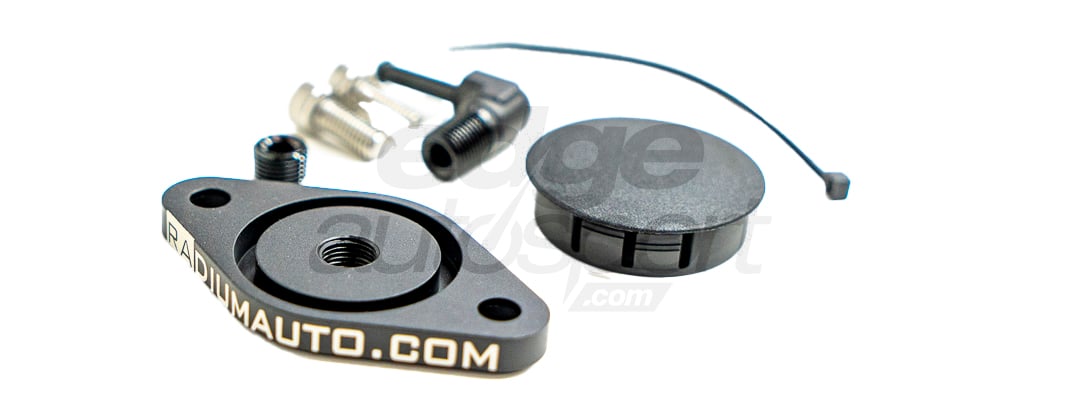
Symposer Delete (Focus ST Only)
There isn't much to this simple, inexpensive device. But it is functional in performance, unlike the vanity of the original symposer that pumps engine noise into the cabin for sound effect. Not that you need it in the first place, but if you modify any part of the exhaust, it becomes irrelevant. Your upgraded exhaust is now louder anyway. Replacing the long plastic tubing and device attached to the intake manifold will primarily do two things. One, it cleans up the engine bay and provides more clearance for anything around it you might be modifying (necessary for use with the Radium PCV catch can on ST models). Two, it adds a useful port to tap into the manifold. This is most often used as a boost/vacuum source for a blowoff valve upgrade when you are upgrading to a big turbo, which is insanely useful. No tapping into any other lines or fishing a long hose across the engine bay. Bada bing, bada boom.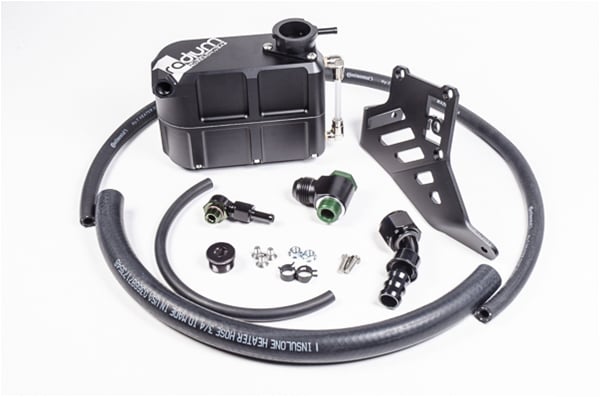
Coolant Tank (All Focus ST and RS Models)
I'll go ahead and say this item is the least necessary for all Focus ST and RS owners that aren't tracking their car regularly. But it's still a much nicer piece to have sitting in your engine bay compared to the big, plastic unit that screams OEM. It's a much nicer CNC machined aluminum that goes with anything else in your engine bay since it's Radium's signature matte black. Beyond the aesthetics, it also provides 160mL more volume than stock and is available with the optional pressure cap with a 21.8psi relief that provides a boiling point increase and better cooling efficiency. To cap that off, there are cross-over passages between the two chambers, of which the header tank has an internal swirl feature, allowing for better air removal from the coolant system.
Fuel Filter (Focus RS Only)
The stock fuel filter, located between the electric pump in the tank and the mechanical pump at the engine is restrictive. The Radium filter is less restrictive, allowing less current draw from the pump and therefore, lower temperature. Because of this, it also allows better flow. So it's like upgrading your fuel pump....without upgrading your fuel pump. This is a simple, no brainer mod for any Focus RS getting modded.
Port Injection Fuel Rail Adapter (All Focus ST and Focus RS Models, also Mustang EcoBoost)
We'll start this off with a good Dad joke. This is the Holy G(rail) of getting crazy power of your Focus ST/RS. Okay, okay, I was just trying to lighten the mood, which is the opposite of what this modification does to your Focus ST. When paired with the right supporting fuel system components, it's all business. The biggest limitation for more easily making a ton of power in the Focus ST and RS is the fuel system. The factory system is no slouch. You can still get a good increase of flow out of it without modification. But once you hit the limit of the injectors, there isn't an aftermarket set that magically opens up the gates to the land of 500whp or more, like there is in other port fuel injection cars with 4 cylinders. Granted XDI has come up with a nice set of injectors and mechanical pumps that allow for a good amount more than the stock units. But they have limitations too. If you're trying to get 450whp or more, you simply have to add an auxiliary fuel system. We're not going in depth on this right now, we've done that in another blog. But this is what you need for big boy power. Radium isn't the only kit on the market, and they're not even the most complete on the market. But the foundational components are included and give you an easy start to add 4 additional injectors to your EcoBoost. As always, it's a very nicely machined and finished part. And if you're wondering, Radium has all the fittings, lines, regulator, surge tanks, etc. to make this as complete of a setup as you can get it. They just let you choose how it's going to operate so they sell the kit with the minimum components necessary before you get into your bespoke setup.
Surge Tank Install Kit
This is a special part and the only one you're going to see for the ST and RS on the market as complete as it is. Surge tanks are sort of a race car thing. If you don't know, they are designed to be a go-between holding place for fuel unaffected by fuel slosh and low fuel conditions that cause fuel starvation. When you load up the car in any direction, fuel sloshes. If it sloshes away from the the pickup while your engine has a high demand for it, you risk starving your engine of fuel which could cause a failure in the blink of an eye. Although this is more of a requirement on a race car, there is still great use for it on any setup due to the increased flexibility of upgrading your pump without touching your fuel tank and the OEM fuel bucket. If you're getting port fuel injection and shooting for 500whp or more, this should be music to your ears. Radium's install kit comes with everything you need to mount a Radium surge tank directly to your car. The factory fuel pump sends fuel to the surge tank and any overflow conveniently returns back through the included adapter that installs in the fuel filler neck. The surge tank itself comes separate so that you can choose what fuel pump you want the tank built for. The surge tank then becomes the primary feed to your HPFP and the port injection rail, if you have one. Make sure you choose a fuel pump with a high enough flow rating to support your horsepower goals.
I'm the founder of Edge Autosport and I remember first getting into cars in high school. I read all the magazines, bought a bunch of technical books, and finally got to start wrenching around the age of 19. I really enjoy modding and being able to live out a passion is truly awesome. I wouldn't change a thing.
Topics:
-web.jpg?width=1083&height=720&name=20-0327-01%20(4)-web.jpg)
-web.jpg?width=1083&height=720&name=20-0327-01%20(5)-web.jpg)
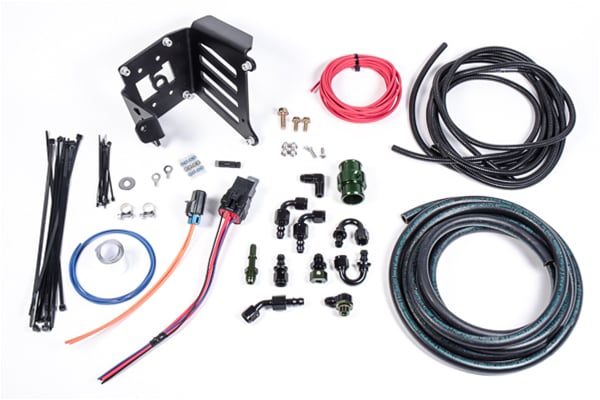
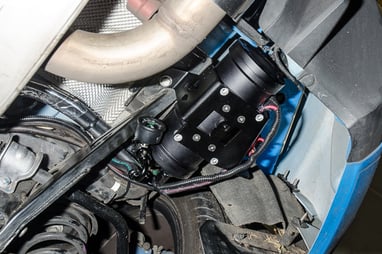
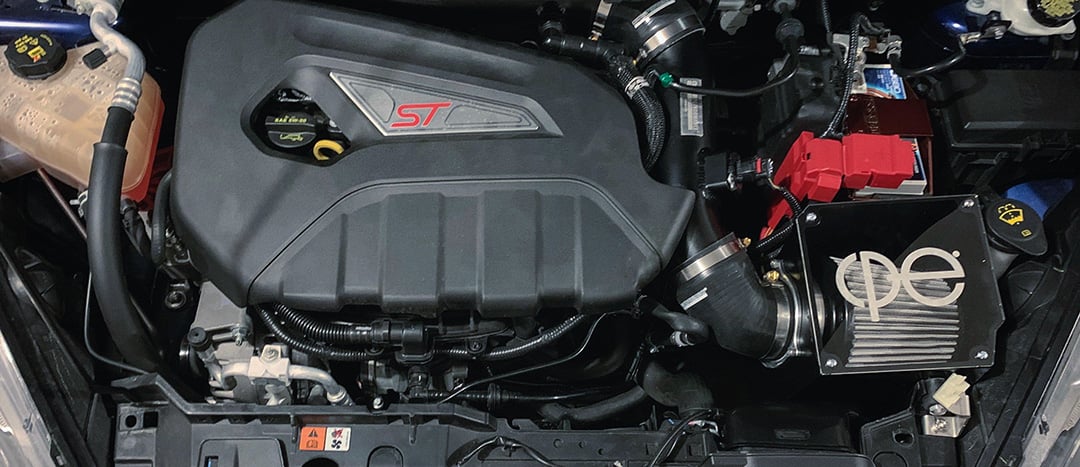

%20-%20Does%20Your%20Big%20Turbo%20Need%20It/EWGKit-web-(2).jpg?width=1018&height=449&name=EWGKit-web-(2).jpg)
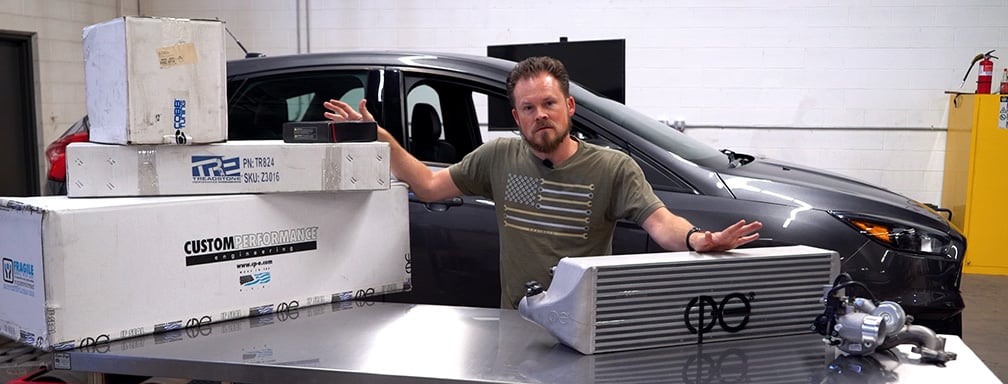

.jpg?width=1024&height=299&name=Putting%20Down%20400whp%20In%20Your%20Focus%20ST%20(2.1).jpg)









